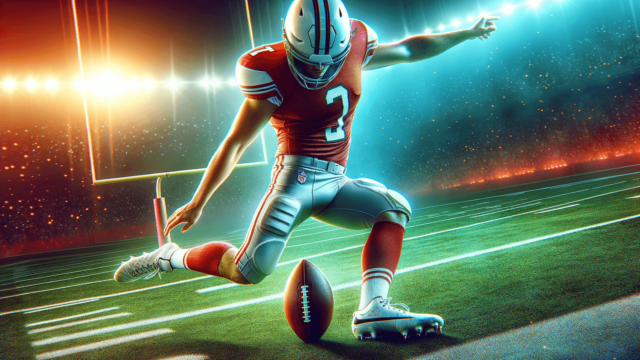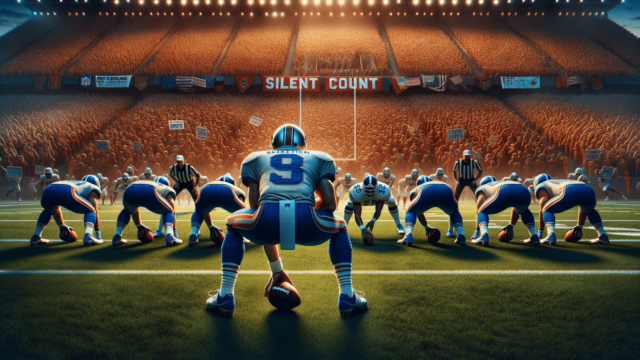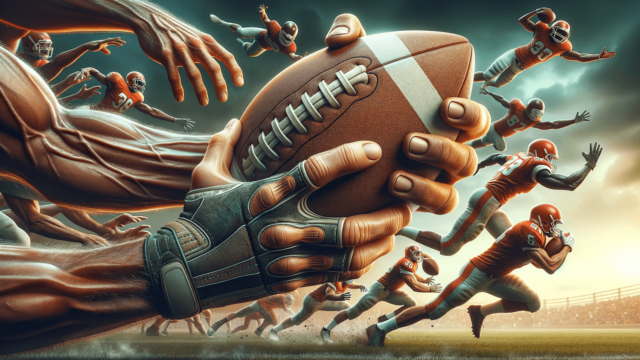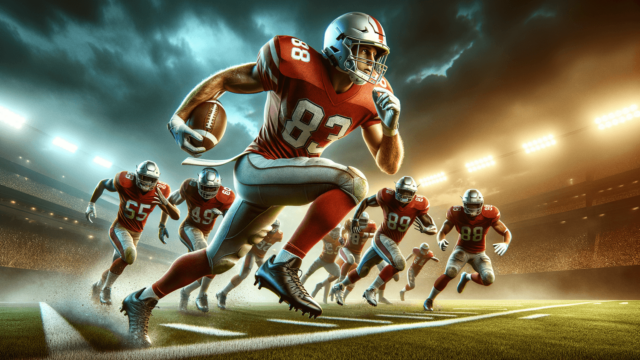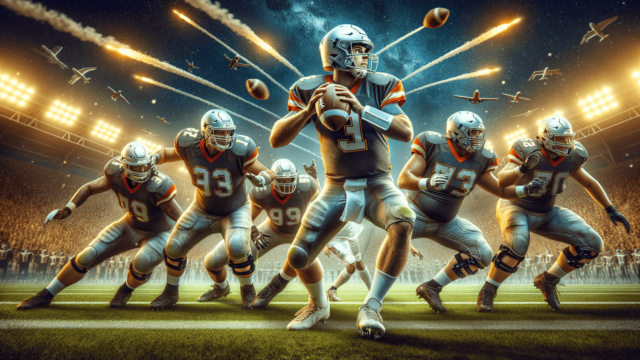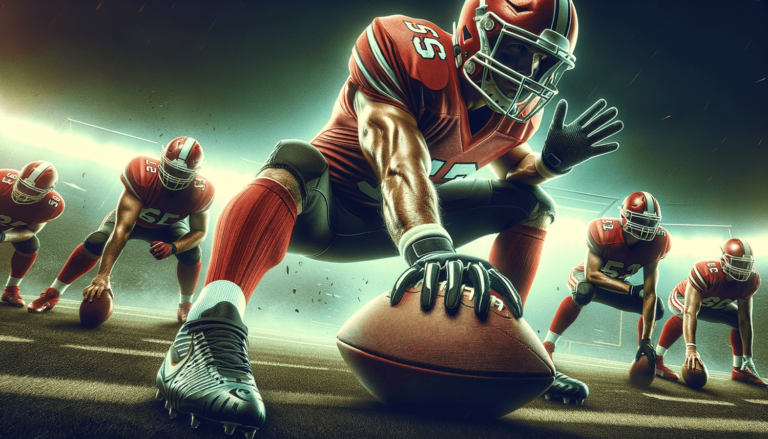
To “snap” a football refers to the center, a specialized offensive linemen, passing the ball between their legs to the quarterback or the holder during different plays. This skill is crucial for a successful offense, requiring a quick and accurate snap and good communication between players. Mastering this skill involves adopting a proper stance, holding the ball securely, executing a prompt and precise snap, finishing the follow-through, and constantly practicing to improve consistency and accuracy.
Understanding the Importance of Snapping
Snapping the football is a critical aspect of the game, as it initiates offensive plays. A good snap ensures proper timing, allowing the quarterback or holder to execute the play effectively. In this blog post, we’ll discuss the key elements of snapping football, including stance, grip, snapping technique, and practice tips.
Adopting the Correct Stance
Before snapping the ball, the center must adopt a proper stance. For traditional snaps, use a three-point stance, with one hand on the ground and the other gripping the ball. While in this stance, maintain a low center of gravity and keep your feet shoulder-width apart. In a shotgun formation, a two-point stance (i.e., both hands on the ball) may be preferable.
Three-Point Stance:
- Place your feet shoulder-width apart.
- Bend your knees to lower your hips.
- Place one hand on the ground in front of your body.
- Grip the ball with your other hand.
Two-Point Stance:
- Stand with your feet shoulder-width apart.
- Lower your hips while keeping your knees bent.
- Place both hands on the ball.
- Keep your head up and eyes focused on the target.
Gripping the Football
Ensure a secure grip on the football by positioning your hand on the laces. The tips of your fingers should press against the laces, providing better control during the snapping motion. Make sure your grip is firm but not too tight, as over-gripping the ball might lead to inaccurate snaps.
Executing the Snap
Once in the proper stance with the right grip, perform the snapping motion. For a traditional snap, quickly push the ball backward through your legs, releasing it so it spins in a spiral motion toward the quarterback. In a shotgun snap, extend your arms and throw the ball directly to the quarterback, keeping the spiral motion tight and accurate.
Traditional Snap:
- Push the ball backward through your legs.
- Release the ball with a tight spiral motion.
- Maintain a balanced stance and follow through with the snap.
Shotgun Snap:
- Extend your arms and throw the ball to the quarterback.
- Keep the spiral motion tight and accurate.
- Maintain a balanced stance throughout the snapping motion.
Practicing to Improve Consistency and Accuracy
Like any skill, snapping the football requires practice to master. Work on your stance, grip, and snapping technique consistently, focusing on the accuracy and speed of your snaps. Consider using drills that simulate live-game scenarios to help you perfect your snapping under pressure.
Developing Strength and Flexibility
In addition to mastering proper technique, football centers need to develop strength and flexibility to execute powerful, accurate snaps consistently. Incorporate strength training and flexibility exercises into your routine, focusing on your core, legs, and upper body muscles, which support the snapping motion.
Communicating with Teammates
Effective communication is crucial when snapping the football. Ensure that both the center and the quarterback or holder are on the same page regarding the snap count and timing. Practice verbal or non-verbal signals to develop seamless, synchronised snaps during game situations.
Perfecting Long Snapping
Long snapping is a specialized skill used during punts and field goals that requires additional distance and accuracy. To perfect your long snapping technique, prioritize the following tips:
- Establish a consistent pre-snap routine.
- Maintain a balanced stance to maximize leverage and power.
- Focus on your release point to ensure a tight spiral.
- Visualize your target and aim for a specific spot.
- Practice, practice, practice!
Analyzing Snap Performance
Continually evaluate your snapping performance during practice sessions and games to identify areas for improvement. Use video analysis tools to study your technique, and consider working with a coach or experienced snapper to receive feedback and guidance.
Dealing with Snap Mistakes
Even experienced centers may occasionally misfire a snap. When this occurs, it’s essential to recover quickly and minimize potential negative effects on the play. Focus on shaking off the mistake and preparing for the next snap – dwelling on an error can lead to more missteps. Training with pressure drills can also help centers become more comfortable in high-stress game scenarios.
FAQ Section: Snapping the Football
In this section, we address some common questions and concerns about snapping the football. These answers will help provide further clarity and understanding of the snapping process and its significance in football.
How can I improve my snapping speed?
To improve your snapping speed, focus on practicing proper technique and developing the necessary muscles through strength training. Emphasize quick releases when practicing, and work on your hand-eye coordination and flexibility. Additionally, perform snap-specific drills to target speed and efficiency.
What is the difference between a short snap and a long snap?
A short snap is used in regular offensive plays, where the center passes the ball to the quarterback positioned a couple of yards behind them. A long snap, on the other hand, is employed during punts and field goals, where the center snaps the ball a more considerable distance – at least 7 to 15 yards – to the punter or holder.
How can I improve my snap accuracy?
Improving snap accuracy requires consistent practice and focused drills. Study your technique using video analysis and work on your aim, follow-through, and release. Practicing with targets and visualization can help develop precision, as can seeking guidance from an experienced coach or snapper.
What are some common snap mistakes to avoid?
Avoid over-gripping the football, which can lead to accuracy issues, and ensure your stance and grip are correct prior to the snap. Timing is also vital, so practice snap counts and communication with your quarterback. In the event of a mistake, remain calm, learn from it, and concentrate on the subsequent play.
How can I practice snapping under pressure?
Simulate high-pressure situations by incorporating game-like conditions into your practice sessions. Set time constraints, use noise distractions, and involve other players to add an element of unpredictability. Practicing snapping under pressure will help improve your overall performance and confidence during actual games.
Featured Posts
- No pillar pages found.
